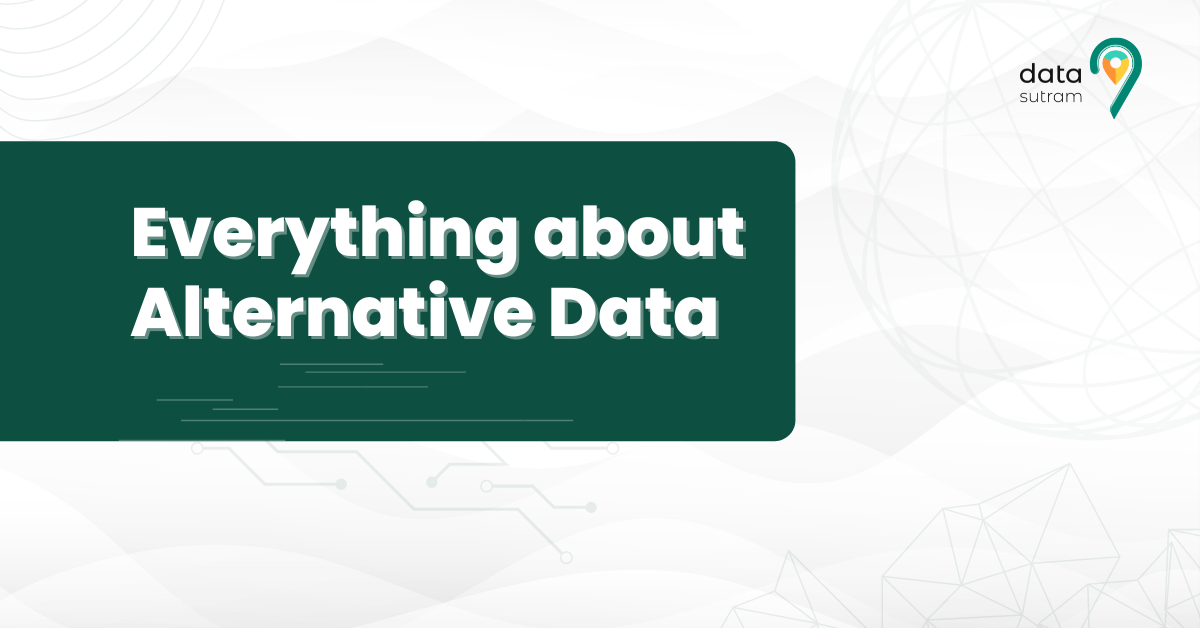Everything about Alternative Data


WHAT IS ALTERNATIVE DATA?
An upward trend was seen in hedge funds; Alternative data is the non-traditional data generated from individuals, business processes, or sensors that aid organizations with comprehensive insights and enhance their decision-making and problem-solving strategies.
Back in the 1600s, when John Graunt concluded death reasons and patterns using death records by London parishes, little did he know that the data about hospital distance from the patient’s home could be an upselling factor in coming times. Or Herman Hollerith’s punch cards had not enough holes to read about the behavioral patterns of people.
Alternative data has always been omnipresent yet dormant, and Data Sutram is here to pull it out from the grave. We can quickly look at the no. of followers of Elon Musk on Twitter and know that he can rule a small country. But, if we consider the possibility that – half of his followers have an app usage of fewer than 10 minutes (daily), then his new nation would be the first to have half of its population as ghosts. And who knows, he might be happier with that.

Although there isn’t a formal definition, hedge funds predominantly use alternative data for better insights to make worthy investment decisions. Alternative data is all the data that isn’t covered under traditional data but is an additive value for conventional data.
According to Statista, more than 53% of hedge fund managers use alternative data to create more intelligent investments.

WHY ALTERNATIVE DATA?
Using alternative data aided companies in readdressing their existing problems, and Data Sutram helped them find AI-driven solutions based on Alternative data. But why were fundamental data methods inadequate to derive insights and intelligence?
While going over these problems, companies realized their hits and (strikethrough) misses. They observed patterns evident in odd results generated by implementing traditional data-driven solutions. Alternative Data primarily gives significant insights through two comprehensive datasets: people and places data. Former data helps a business understand its consumers’ behavior, whereas the latter elaborates on the info about the place where this behavior occurs. This opens a gateway for companies providing them with a new data dimension.
From scraping data from obscured city hall records to social media usage, Data Sutram has successfully scraped data from 250+ sources to the present.
HOW ALTERNATIVE DATA IS COLLECTED
If alternative data is the oil, then where’s the extraction happening? There’s no comprehensive list of where we can look for alternative data; instead, it is ubiquitous. Alternative data is accessed in structured or unstructured form; we can find it everywhere, even in places from our subconscious. The whole process of alternative data collection is completely authorized, legal, and regulated.
There aren’t many predefined data sources since one can retrieve alternative data from multiple sources, just like Data Sutram provides insights and intel based on its 250+ sources.
When collected from an individual, this data is non-PII and can be app usage, social media usage, buying habits, and email receipts, benefiting retail companies, the BFSI sector, and other consumer-centric businesses. This is facilitated using MAIDs.
We can collect supply chain data, banking records, corporate data, etc., from businesses, and sensors can help us with weather data and satellite images. A common hesitation is often seen among businesses, but alternative data is entirely ethical and doesn’t harm someone’s identity.
WILL ALTERNATIVE DATA AFFECT MY PRIVACY?
In the data world, whenever an organization or an authority collects consumer data, user data or data that pertains to various individual compliances such as GDPR restricts them to hindering an individual’s privacy and abiding by the six privacy principles i.e.
- Purpose limitation.
- Fairness, lawfulness, and transparency.
- Data minimization.
- Storage limitation.
Similar principles are taken care of when collecting alternative data; moreover, the nature of alternative data prevents it from breaching an individual’s privacy. Alternative data parameters such as transactional data, affluence, income group and others are available as gross information of a particular granularity of geography that blankets the information of an individual living in that area. Similarly, other data parameters, such as social media usage, app usage, and digital behavior, when collected, don’t contain the metadata of an individual; instead are encrypted and are identified using unique ids, which again prevents breaching an individual’s privacy.
HOW DO YOU USE ALTERNATIVE DATA?
The applications and use cases of alternative data spar various sectors and domains. There are multiples benefits to companies:
- Identifying gaps
- Preventing overspends in field-force
- Fraud Analysis
- Inventory Management
- Credit Underwriting
- Customer and Market acquisition
- Specific POS ecosystem
- Customer profiling
- NPA Reduction
- Opportunity Analysis
- Identifying marketing pockets
Not only this, but using alternative data leads to optimization, increased ROI, and aids in managing field force resources.
Data Sutram aims to help these businesses by providing insights, intel, and AI-driven solutions based on alternative data, leading the data-driven market in India.